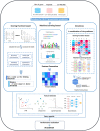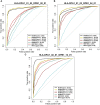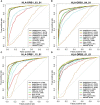MHCII-peptide presentation: an assessment of the state-of-the-art prediction methods
- PMID: 38646540
- PMCID: PMC11027168
- DOI: 10.3389/fimmu.2024.1293706
MHCII-peptide presentation: an assessment of the state-of-the-art prediction methods
Abstract
Major histocompatibility complex Class II (MHCII) proteins initiate and regulate immune responses by presentation of antigenic peptides to CD4+ T-cells and self-restriction. The interactions between MHCII and peptides determine the specificity of the immune response and are crucial in immunotherapy and cancer vaccine design. With the ever-increasing amount of MHCII-peptide binding data available, many computational approaches have been developed for MHCII-peptide interaction prediction over the last decade. There is thus an urgent need to provide an up-to-date overview and assessment of these newly developed computational methods. To benchmark the prediction performance of these methods, we constructed an independent dataset containing binding and non-binding peptides to 20 human MHCII protein allotypes from the Immune Epitope Database, covering DP, DR and DQ alleles. After collecting 11 known predictors up to January 2022, we evaluated those available through a webserver or standalone packages on this independent dataset. The benchmarking results show that MixMHC2pred and NetMHCIIpan-4.1 achieve the best performance among all predictors. In general, newly developed methods perform better than older ones due to the rapid expansion of data on which they are trained and the development of deep learning algorithms. Our manuscript not only draws a full picture of the state-of-art of MHCII-peptide binding prediction, but also guides researchers in the choice among the different predictors. More importantly, it will inspire biomedical researchers in both academia and industry for the future developments in this field.
Keywords: MHCII; bioinformatics; immunology; machine learning; peptide binding prediction; webserver.
Copyright © 2024 Yang, Wei, Cia, Song, Pucci, Rooman, Xue and Hou.
Conflict of interest statement
The authors declare that the research was conducted in the absence of any commercial or financial relationships that could be construed as a potential conflict of interest.
Figures





Similar articles
-
Predicting CD4 T-cell epitopes based on antigen cleavage, MHCII presentation, and TCR recognition.PLoS One. 2018 Nov 6;13(11):e0206654. doi: 10.1371/journal.pone.0206654. eCollection 2018. PLoS One. 2018. PMID: 30399156 Free PMC article.
-
NetMHCIIpan-3.0, a common pan-specific MHC class II prediction method including all three human MHC class II isotypes, HLA-DR, HLA-DP and HLA-DQ.Immunogenetics. 2013 Oct;65(10):711-24. doi: 10.1007/s00251-013-0720-y. Epub 2013 Jul 31. Immunogenetics. 2013. PMID: 23900783 Free PMC article.
-
An automated benchmarking platform for MHC class II binding prediction methods.Bioinformatics. 2018 May 1;34(9):1522-1528. doi: 10.1093/bioinformatics/btx820. Bioinformatics. 2018. PMID: 29281002 Free PMC article.
-
A comprehensive review and performance evaluation of bioinformatics tools for HLA class I peptide-binding prediction.Brief Bioinform. 2020 Jul 15;21(4):1119-1135. doi: 10.1093/bib/bbz051. Brief Bioinform. 2020. PMID: 31204427 Free PMC article. Review.
-
For many but not for all: how the conformational flexibility of the peptide/MHCII complex shapes epitope selection.Immunol Res. 2013 May;56(1):85-95. doi: 10.1007/s12026-012-8342-2. Immunol Res. 2013. PMID: 22753017 Free PMC article. Review.
Cited by
-
To stay or not to stay intact as an allergen: the endolysosomal degradation assay used as tool to analyze protein immunogenicity and T cell epitopes.Front Allergy. 2024 Jul 12;5:1440360. doi: 10.3389/falgy.2024.1440360. eCollection 2024. Front Allergy. 2024. PMID: 39071040 Free PMC article. Review.
-
Immunoinformatics Predictions on Variable Mycobacterium tuberculosis Lineage 6 T Cell Epitopes and HLA Interactions in West Africa.Microorganisms. 2025 Apr 29;13(5):1032. doi: 10.3390/microorganisms13051032. Microorganisms. 2025. PMID: 40431205 Free PMC article.
-
TransHLA: a Hybrid Transformer model for HLA-presented epitope detection.Gigascience. 2025 Jan 6;14:giaf008. doi: 10.1093/gigascience/giaf008. Gigascience. 2025. PMID: 40036690 Free PMC article.
-
Molecular targets and strategies in the development of nucleic acid cancer vaccines: from shared to personalized antigens.J Biomed Sci. 2024 Oct 9;31(1):94. doi: 10.1186/s12929-024-01082-x. J Biomed Sci. 2024. PMID: 39379923 Free PMC article. Review.
References
Publication types
MeSH terms
Substances
LinkOut - more resources
Full Text Sources
Research Materials

